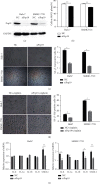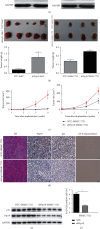Prp19 Facilitated p21-Dependent Senescence of Hepatocellular Carcinoma Cells
- PMID: 35356253
- PMCID: PMC8959953
- DOI: 10.1155/2022/5705896
Prp19 Facilitated p21-Dependent Senescence of Hepatocellular Carcinoma Cells
Abstract
Introduction: Evidence suggests that the role of senescence in the development of cancer is context-dependent. An orthologue of human pre-mRNA processing factor 19 (Prp19) attenuates the senescence of human endothelial cells. Prp19 has been reported to be involved in the progression of hepatocellular carcinoma (HCC). This work aims to investigate the effect of Prp19 on the senescence of HCC.
Materials and methods: Senescence of L02 cells and HCC cells under different stimuli was detected through cell cycle analysis, SA-β-gal staining, and senescence associated secretory phenotype analysis. The relationship between Prp19 and senescence-related proteins was evaluated using real-time RT-PCR, western blot assay, and immunohistochemistry. Subcutaneous xenograft tumors in nude mice were used to evaluate the role of Prp19 on senescence in vivo. Data analysis was carried out using GraphPad Prism 6.
Results: Prp19 facilitated the senescence of L02 cells and HCC cells under different stresses. Prp19 positively modulated p21 expression in the mRNA level. Downregulation of Prp19 promoted the growth of subcutaneous xenograft tumors generated by HCC cell lines.
Conclusions: Prp19 may promote senescence of HCC cells via regulating p21 expression.
Copyright © 2022 Jie Yin et al.
Conflict of interest statement
The authors declare no conflicts of interest.
Figures




References
LinkOut - more resources
Full Text Sources
Miscellaneous

